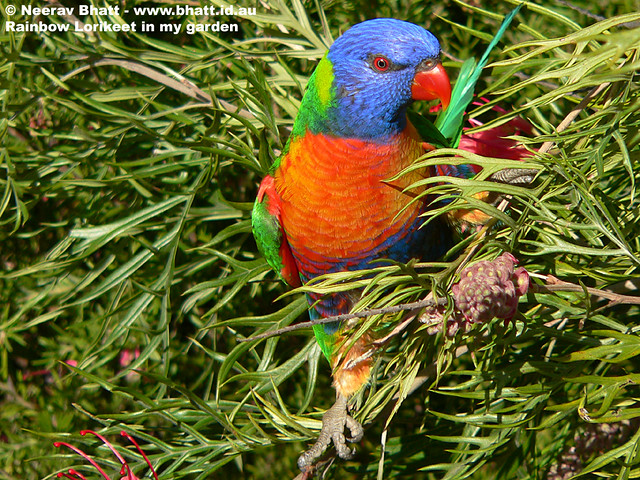Rainbow Lorikeets (Trichoglossus haematodus) are a very colourful member of the parrot species which I love to photograph because of their multi coloured feathers and cheeky behaviour, they are commonly found in towns, big cities and out in the bush.
These birds are native along the east coast of Australia (Queensland, NSW and Victoria). However they are are also found in Tasmania, parts of South Australia, Northern Territory and south-west Western Australia where they are considered a pest by some people such as fruit farmers.
The NSW Department Office of Environment and Heritage (OEH) says Rainbow Lorikeets tend to roost in large groups and can be seen just on dusk, arriving by the hundreds at their favourite roosting place, usually in tall eucalypts. I have seen these flocks in many places around Sydney, from the inner West to the South Eastern suburbs, as well as on the South coast while on holiday at Narooma.
Though males and females behave differently, it’s very hard to tell them apart just by their appearance. Their behaviour is quite comical at times, especially at mating time, when the male tries to impress the female with a display of bobbing, bowing and prancing like a true showman!
Rainbow Lorikeets are very cheerful birds. The sound of them calling to each other is quite distinctive and easy to recognise though all you may see is a brief splash of colour from their plumage as they zoom overhead.
The OEH warns people that eating biscuits, bread or seeds provided by humans can cause damage to the tongue and beak of Rainbow Lorikeets, which causes them to become very sick and die. Rainbow Lorikeets may become dependent upon these unnatural sources of food and become less inclined to forage in the wild.
So let them feed on the pollen and nectar in native flowering plants by planting these in your garden. Nectar gives them energy, and pollen provides protein for healthy feathers. They also feed on fruits and small insects. Trees with hollows are perfect for Rainbow Lorikeets to make nests and they are much more likely to visit your garden if there aren’t any cats or dogs which will chase them.
These are some of my favourite Rainbow Lorikeet photos taken across the years (oldest to newest):














Leave a Reply